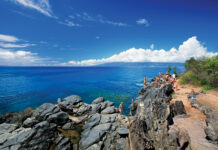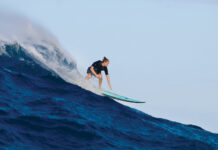In recent months, he told us, he had hosted crews from National Geographic and the Discovery Channel, all seeking, like us, a glimpse of creation in action.
Soon it was time to head back over the ocean swells, which the sea captain claimed were pretty calm today. “This is not the tour for everybody,” he conceded. And while Lava Ocean Adventures’ bigger boat, the thirty-four-foot Lono, is a more comfortable ride, Shane said only those who are fit and venturesome should consider any boat trip along the rough-water east coast of Hawai‘i.
Lava watching is an unpredictable business. “I can’t tell you what it’s going to be like” on any given day, Shane said, and he never takes reservations more than a month out, because Pele could decide at any moment to turn off the faucet. He also tends to get lots of last-minute passengers, people who were disappointed when they hiked out to the official viewing point or flew overhead in a helicopter.
My co-passengers, North Carolinians Frank Tate and Cynthia Gibas, had tried both of those trips. Which did they like best? Frank put it succinctly: “This wins!”
Having experienced the wild ride on the LavaKat, I’d choose the larger boat next time. But I would certainly take the ride, bumpy as it might be even on the Lono, for the chance to pursue my longtime love affair with lava. After all, what’s an adventure without a little adrenaline on the way?
Go with the Flow
Are you up for the ocean tour? Contact Captain Shane Turpin of Lava Ocean Adventures at (808) 990-0553, or check the website lava-ocean.com. Wear comfortable shoes and bring a light jacket.
At this writing, on-land viewing is located outside Hawai‘i Volcanoes National Park at the lava-truncated end of Highway 130/137. The viewing area may change or be closed at any time. Be prepared for a long hike over very rough lava. Wear sturdy shoes and long pants and bring a backpack with two to three quarts of bottled water per person. The site is open from 2 p.m. to 10 p.m. Flashlights are essential after 6 p.m.
Lava viewing conditions are unpredictable and constantly changing, so check for updates when you are actually ready to see the flow, whether by sea, by air or by land. For the latest, go to the national park’s site, or the Big Island Visitors Bureau site. You’ll also find current information and great movies of lava in action at the park’s Visitor Center at the Kilauea summit.





